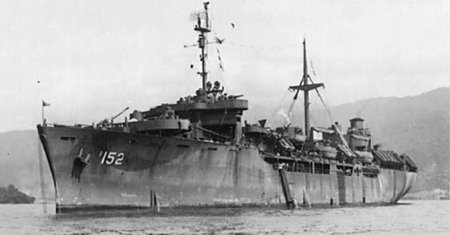S.S Poet - Lost in Bermuda Triangle
S.S. Poet was initially built as a transport ship for the US Navy in 1944 during World War II. It transported troops regularly until 1949, and then there was a long gap when it virtually remained idle. It went through changes in ownership and was finally taken over by the company Hawaiian Eugenia Corp in 1979. By then it was already converted into a bulk cargo carrier.
This massive 522-ft ship carrying 13,500 tons of yellow corn and crew of 34 left the port at Girard Point of Philadelphia on October 24, 1980 early in the morning. It was another routine trip to the port Said at Egypt to transport bulk corn. While leaving, the pilot of the ship Capt. Gary Harper reported that the ship was quite heavy on the bow (i.e. front part of the hull) and was slow in responding to the wheels. But that wasn't anything to be concerned about.
SS Poet
Source: Historic Gloria Dei Preservation Corporation
The ship was given the green signal and it slowly began its cruise through the Delaware river towards the Atlantic. At 8:30am while passing by Cape Henlopen, the ship reported its position, and that was the last transmission received from Poet. Neither there was any SOS signal indicating distress. Before anyone could sense any problems, the Poet was lost.
The ship had to report its position and fuel level every two days to the Marine Administration. After 9 days (i.e. on November 3, 1980) when the ship was to reach its destination in Egypt, the owners of the ship reported that they were unable to trace the ship and did not hear from it after October 24th. No one knew why they reported the loss so late.
This delay in reporting was costly because nobody had a clue about the location of Poet on November 3rd. A massive search operation was initiated by the US Coast Guard covering an area of 290,000 square miles starting from Cape Henlopen where the last position was known and all the way up to the Straits of Gibraltar. But no trace of the ship was found, neither of its 34-member crew. Many ships passed through the scheduled route of the Poet and many planes flew over it after it was reported lost, but none could see any debris, floats or oil leakage.
Two days after the ship left port at Philadelphia, there was a short auto alarm received at the radio control tower at Baltimore. But it came in and went out abruptly. It could never be ascertained if the signal came from the Poet. But if it did, the location indicated that the ship was right at Bermuda Triangle at the edge of
Sargasso Sea.
What happened to SS Poet?
The ship Poet and all its crew disappeared and remain untraceable to date. Several explanations have been forwarded by different investigating bodies, but none are conclusive.
Here are some of the more plausible ones:
The onboard inspection conducted by the Coast Guard officer before Poet left the port at Philadelphia noted a few issues. There were couple of large oil containers onboard which did not have padding under them and thus were susceptible to sparks if they moved while the ship was in motion. But this was not considered a big risk.
Also the ship was not carrying the instrument called Loran used for navigational purpose. With a veteran captain having 41-years of marine experience and knowing the route by heart, a Loran wouldn't have been used anyway.
The hatch of one of the cargo holders was defective. So if in rough weather the hatch gave way and the holder got flooded, that could cause a disaster. But the Poet had been cruising with the defective hatch for years and it was not considered a real threat. In fact the US Coast Guard report mentioned that structural failure was unlikely. The ship went through several inspections not long before its voyage including that of the hull and it was found in seaworthy condition.
The weather report confirmed that the day after Poet left the port (i.e. 25th Oct 1980) there was a strong cyclone on the Atlantic moving at 60-knots and causing waves as high as 30-ft. The storm kept lashing at the coast for the next two days. It was highly likely that Poet was caught into the storm. However experts opined that Poet had encountered far more severe cyclones in the past and had the capacity to easily withstand storms of such nature. Also, several other vessels passed through the storm around the same time and along the same ocean area without much problems.
The final Maritime Casualty Report produced by the Coast Guard mentioned that likely the Poet was lost between 25th and 26th October when it faced the worst weather conditions. To the question why no signal was received, the report mentions that the ship could have sunk so quickly with all its crew that there was no time to transmit any signal. The report also says that the real cause of such casualty and loss could not be determined.
|
 By Raj Bhattacharya By Raj Bhattacharya
Raj, a seasoned travel writer and Bermuda destination expert, has extensive global travel experience. This website reflects his profound insights, garnered over nearly two decades of dedicated findings and research on the island. Raj has assisted countless Bermuda-bound visitors by providing direct, personalized responses to their queries and imparting his wealth of knowledge through this platform. This site serves as an indispensable guide for those seeking informed and reliable insights into Bermuda's treasures.
|
Related Articles
|
Visitors' Reviews and Comments
Share your experience.
|

 By Raj Bhattacharya
By Raj Bhattacharya